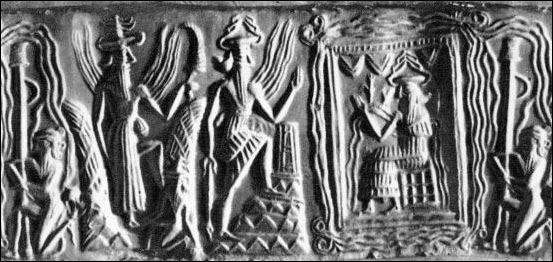 |
Date Second half of the third millennium B.C. [--Parrot.] Origin The Ancient World : The Middle East : Sargonid Period Description Left and right, kneeling figure embracing buckled shaft marking shrine; right, Ea (Enki) enthroned in his shrine (the Apsu) formed of the rising and falling waters of the abyss; left, two solar gods, one with leg extending from skirt, standing with one foot on winged lion while other foot steps on crouching deity (Kramer), treading on lion between two mountains (Woolley), between wings (Levy), holding saw-knife the other god climbing ziggurat, both wearing four-horned crown, both with flames or rays rising from shoulders. Woolley conjectures that the gods may be the Akkadian Shamash and the Sumerian Utu who correspond to one another. Possibly such scenes illustrate ritual dramas performed in the temples upon feast days. Levy comments that Marduk [left] combined the perpetual functions of the sun-god and the gods of vegetation. On this seal he duplicates the gesture of Shamash [center] before his father Ea. Marduk springs not from the twin peaks of the sunrise, but from between the wings which represent the split body of Tiamat, of Chaos, whom he caught in his net of ordered being, mentioned in the texts as a dove flung down. Since gods are not killed, the battle which Marduk fought on the day of creation was eternally repeated. At the yearly re-enactment in Babylon, the king renewed on the ziggurat both his own reign and the life of the land. Kramer writes that Enki, the Sumerian water-god, is shown in his "sea house" in the abyss, described in Sumerian myth. From an incomplete text Kramer surmises that Enki was conceived of as a sea god because of his victory over the nether world dragon Kur who fought with stones and the primordial waters as its weapons. The figure to left of center is identified as Utu, the Sumerian sun-god, by Kramer who notes that the deity climbing mountain between Utu and Enki is not yet identifiable. The kneeling figure is probably an attendant of Enki. Object Seal (cylinder; impression; stone; ht. 1 3/8"). Style or School Akkadian. Material or Technique Glyptic. Provenance Found at Ur. Repository or Site Baghdad: Mus., Iraq. Image Sources from Parrot.* [JF 1297] References *Parrot, A., Sumer (1961), pl.240. Woolley, C. L., Art (1961), p.86; fig.25. Levy, G. R., Gate (1948), p.172, fig.23c. Kramer, S. N., Sumerian (1961), pp.40,62,79; pl.10. |